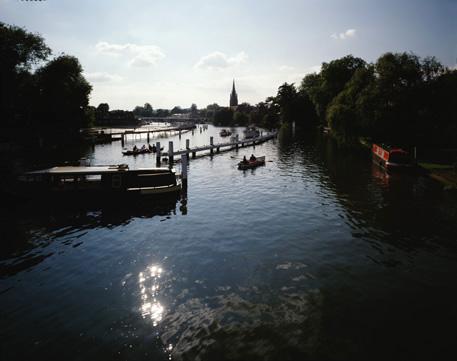
Photograph copyright ©1999 - 2018 Denis Waugh.
External Links
MARLOW
Plans in 1966 to demolish Marlow's elegant suspension bridge, completed in 1836, were fortunately defeated and it was renovated instead. But one suspects the impatient rush-hour traffic gives not a jot for Tierney Clarke's masterpiece. The bridge allows for single lane crossing only, so when they get the go-ahead the drivers follow too close to each other. A Volvo has hit a Rover in the back, crumpling it severely, but the Volvo has simply suffered no more than some scratched paint, and the Volvo driver, getting out his business card, looks positively smug.
Percy Bysshe and Mary Shelley lived in Albion House, West Street, now named Shelley Cottages, between 1816 and 1817. Shelley Cottages is an attractive little whitewashed rough-cast terrace with scalloped windows which do credit to some extraordinary craftsman. In 1867 Sir William Robert Clayton, Bart, placed a tablet on the parapet inscribed:
He is gone where all things wise and fair...
Death feeds on his mute voice and laughs at our despair
When the Shelleys lived here, the lace-making trade, for which the town was famous, was in the doldrums and Marlow was hit by severe poverty. Although never destitute - `Bysshe' expected to inherit a substantial family estate - the Shelleys were always short of money and Albion House suffered from damp, so they felt they had some idea of poverty. Shelley provided blankets, food and other necessities for the poor and the rich thought he was mad.
The lace-makers were not alone in their difficulties. When the weavers' demand for a minimum wage led to the use of troops by employers and property owners to `keep the peace', Shelley was incensed. His revolutionary instincts were aroused and he wrote The Revolt of Islam, a symbolic tale which illustrates, as Shelley says `the growth and progress of individual mind aspiring after excellence and devoted to the love of mankind... and its impatience at all the oppressions that are done under the sun.'
Shelley longed for the ideal society. His wife Mary, the daughter of William Godwin and the feminist Mary Wollstonecraft, was a grafter. She wrote Frankenstein while they lived in Marlow and she worked hard at her novels and stories after his death. Shelley saw the reconstruction of society as his work. While living here, writing as `The Hermit of Marlow' he published A proposal for Putting reform to the Vote, and when Princess Charlotte, the popular daughter of George IV and his despised wife Caroline of Brunswick, died in childbirth in November 1817 he wrote `An Address to the People on the Death of Princess Charlotte'.
The Shelleys had been encouraged to Marlow by one of the more down to earth of Shelley's friends, Thomas Love Peacock, who also lived in West Street in a house which is now a motoring superstore. Although he supported a good many of Shelley's beliefs, Peacock was perhaps a little more worldly and cynical in his espousal of the means for social betterment. Also, whereas Shelley, despite his frequent lack of money, never actually considered that he might get a job, Peacock was very much of the establishment, holding an important post with the East India Company.
Shelley's hypochondria must have driven Mary to despair as he variously supposed himself to have elephantiasis and consumption. But it was not illness that finally despatched him; he drowned in 1822, sailing in the Mediterranean.
At Oxford his father had introduced Percy Bysshe to the local booksellers and printers Slatter and Munday: `My son here has a literary turn... do pray indulge him in his printing freaks.'
Yet Timothy Shelley, so keen to further his son's literary interests at University College, forbade the publication of any of his works after his death on pain of ending his allowance to Mary and Percy Florence, their only surviving child.
Text copyright ©1999 - 2018 Priscilla Waugh.